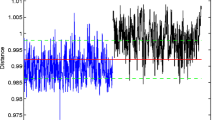Abstract
The performance of target recognition in VHF radar is evaluated through the use of support vector machine (SVM) classifier. Automatic target recognition in low resolution radars has been an interesting research issue for many years. Indeed, some intrinsic properties of low resolution radars such as low pulse repetition frequency, narrow bandwidth and low time on target, restrict the accuracy of target recognition in such systems. Since high range resolution (HRR) techniques cannot be used in these radars, a fast Fourier transform (FFT) is applied in the pre-processing step. In this paper, it is shown that adequate use of an accurate classifier such as SVM provides acceptable results even when a simple FFT is applied. Two different multi-class SVM algorithms: one versus one (OVO) and one versus all (OVA), are analyzed by taking four conventional kernel functions into account. To properly evaluate the performance of a classifier a large enough dataset is required. Therefore, huge amount of data points are modeled using Gaussian mixture model based on the parameter vectors that are extracted from real data of helicopter, airplane and fighter aircrafts. The classifier performance is evaluated by calculating probability of correct classification, reliability factor and central processing unit calculation time for each algorithm.











Similar content being viewed by others
References
Afifi A, Zanaty EA, Ghoniemy S (2013) Improving the classification accuracy using support vector machines (SVMs) with new kernel. J Global Res C Sci 4(2):1409–1424
Andral PS (2002) The equivalence of support vector machine and regularization neural networks. Neural Process Lett 145(2):97–104
Baker C (2011) Pulse Doppler radar target recognition using a two-stage SVM procedure. IEEE T Aerosp Electron Syst 47(2):1450–1457
Borden B (1999) Radar Imaging of Airborne Targets a Primer for Applied Mathematicians and Physicists. Naval air warfare center weapons division China lake, California
Boulay T et al (2013) High-dimensional range profile geometrical visualization and performance estimation of radar target classification via a gaussian mixture model. J Geom Sci Inf 8085:829–836
Chalechale A, Safaei F (2008) Visual-based interface using hand gesture recognition and object tracking. IJSTE 32(B3):279–293
Chen V, Cripps SC (2011) The micro-Doppler effect in radar. Artech House, London
Chongming W, Xiaodan W, Chunying Z (2008) Classifying HRRP by AdaBoostSVM. In: ICSP, Beijing, Oct 26–29, pp 1582–1585
Du J, Hu Y, Jiang H (2011) Boosted mixture learning of gaussian mixture hidden markov models based on maximum likelihood for speech recognition. IEEE Trans Audio Speech 19(7):2091–2100
Du L, Wang B, Li Y, Liu H (2013) Robust classification scheme for airplane targets with low resolution radar based on EMD-CLEAN feature extraction method. IEEE Sensor J 13(12):4648–4662
Duan K, Keerthi SS, Poo AN (2003) Evaluation of simple performance measures for tuning SVM hyperparameters. J Neurocomput 51:41–59
Eravci B, Barshan B (2012) Automatic radar antenna scan type recognition in electronic warfare. IEEE Trans Aerosp Electron Syst 48(4):2908–2931
Gini F, Rangaswamy M (2008) Knowledge-based radar detection tracking and classification, 1st edn. Wiley, New Jersey
Guo Y et al (1999) Covering numbers for support vector machines. IEEE Trans Inf Theory 48:239–250
Helzel T, Kniephioff M, Petersen L (2010) Oceanography radar system WERA: features, accuracy, reliability and limitations. Turk J Electr Eng Comput Sci 18(3):389–397
JalaliRad A, Amindavar H, Kirlin RL (2011) Characteristic function based method for SVM classification of maneuvering over the horizon targets. In: IEEE Africon 2011 Conf., Livingstone, Sept 13–15, pp 1–4
Jinsha Y et al (2008) K-mean algorithm with a distance based on the characteristic of differences. In: I C WIREL COMM NETW., Dalian, Oct 12–14, pp 1–4
Jun W, Jinping S, Peng L (2014) Classification of free rigid targets with micro-motions using inertial characteristic from radar signatures. IEEE Electron Lett 50(13):950–952
Kim KT, Seo DK, Kim HT (2002) Efficient radar target recognition using the MUSIC algorithm and invariant features. IEEE T Antennas Propag 50(3):325–337
Kuschel H (2002) VHF/UHF radar part 2: operational aspects and applications. Electron Commun Eng 14(3):101–111
Kylmala J et al (2013) Search radar modification for long range ISAR target recognition. In: IEEE 14th Int. Radar. Symp., Dresden, June 19–21, pp 597–600
Lakshmanan V et al (2012) A statistical approach to mitigating persistent clutter in radar reflectivity data. IEEE J Sel Topics Appl Earth Obs 5(2):652–662
Lakshmi SL et al (2010) Doppler profile estimation in VHF radar signals using wavelets. In: ICSP, Chennai, Dec 15–17, pp 243–249
Li S, Wang M, He J (2013) Prediction of banking systemic risk based on support vector machine. Math Probl Eng. 2013:1052–1067
Lia Q, Xiea W (2013) Classification of aircraft targets with surveillance radars based on fuzzy fractal features. J Electromagn Wave 27:65–77
Liu H et al (2005) Radar high range resolution profiles recognition based on wavelet packet and subband fusion. In: IEEE. Int. Conf. Acoust. Spee., Philadelphia, Mar 18–23, pp v/445–v/448
Maji S, Berg AC, Malik J (2013) Efficient classification for additive kernel SVMs. IEEE Trans Pattern Anal 35(1):66–77
Matej K, Aleˇs L (2013) Online discriminative kernel density estimator with gaussian kernels. IEEE Trans Cybern 44(3):55–365
Molchanov PO et al (2013) Moving target classification in ground surveillance radar ATR System by using novel bicepstral-based information features, EURASIP. J Adv Signal Proc 2013:1–13
Nanzer JA, Rogers RL (2009) Bayesian classification of humans and vehicles using micro-Doppler signals from a scanning-beam radar. IEEE Microwave Wirel Compon Lett 19(5):338–340
Peng L et al (2011) Automatic classification of radar targets with micro-motions using entropy segmentation and time-frequency features. Int J Electron Commun (AEU) 65(10):806–813
Sangeetha R, Kalpana B (2011) Performance evaluation of kernels in multi-class support vector machines. Int J Soft Comput Eng 1(5):138–145
Setlur P, Ahmad F, Amin M (2011) Helicopter radar return analysis: estimation and blade number selection. J Signal Process 91(6):1409–1424
Smith GE et al (2008) Radar classification evaluation. In: IEEE Radar. Conf., Rome, May 26–30, pp 1–6
Strausberger DJ et al (1992) Modeling and performance of HF/OTH radar target classification systems. IEEE T Aerosp Electron Syst 28(2):396–403
Tait P (2008) Introduction to radar target recognition (Radar, Sonar and Navigation). Institution of engineering and technology, London
Wang X, Paliwal KK (2003) Feature extraction and dimensionality reduction algorithms and their applications in vowel recognition. J Pattern Recognit 36(10):2429–2439
Wei C et al (2012) An approach for high resolution radar target recognition based on BP neural network. Lect Notes Comput Sci 6838:33–39
Woodbridge K, Baker CJ, Smith GE (2008) Naïve Bayesian radar micro-Doppler recognition. In: IEEE Radar. Conf., Adelaide, Sept 2–5, pp 111–116
Youngwook K, Sungjae H, Jihoon K (2015) Human detection using Doppler radar based on physical characteristics of targets. IEEE Geosci Remote Sens Lett 12(2):1831–1834
Yunfei S et al (2011) Landmine detection using boosting classifiers with adaptive feature selection. In: IWAGPR, Aachen, Jun 22–24, pp 1–5
Zyweck A (1995) Preprocessing issues in high resolution radar target classification, PhD Thesis, University of Adelaide, Advanced Institute of Science and Technology, Australia
Author information
Authors and Affiliations
Corresponding author
Rights and permissions
About this article
Cite this article
Khodkar, Z., Alavi, S.M. Target Classification Enhancement in VHF Radar Using Support Vector Machine. Iran. J. Sci. Technol. Trans. Electr. Eng. 40, 51–62 (2016). https://doi.org/10.1007/s40998-016-0004-2
Received:
Accepted:
Published:
Issue Date:
DOI: https://doi.org/10.1007/s40998-016-0004-2




